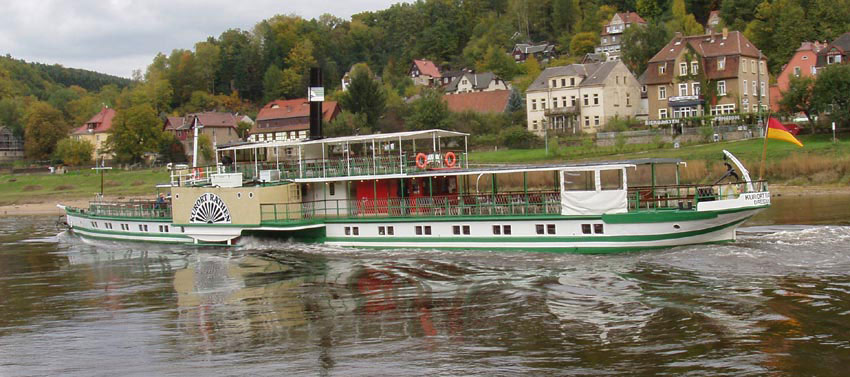
In Germany, just south of Dresden is the area called Saxon Switzerland where the Rive Elbe flows through stunning scenery between tree lined banks and rocky crags linking charming little hamlets and villages seemingly plucked straight out of the fairy tales of the Brothers Grimm. Here also is the world’s greatest concentration of operating paddle steamers with nine of them in regular service running between Decin in the Czech Republic in the south and Meissen downstream from Dresden in the north. It is a paddle steamer wonderland with many services operating from the early spring through to November; the shorter cruises from Dresden generally being available in the run up to Christmas; and the paddlers being available throughout the year for special sailings. One of these steamers is the Kurort Rathen pictured above off the village of Stadt Wehlen in October 2003. She was built in 1896 as the Bastei and, at fifty five metres in length, could originally accommodate 621 passengers with a crew of 8. Now she has certificates for 300 with a crew of 3: a captain, an engineer and a seaman plus catering crew.
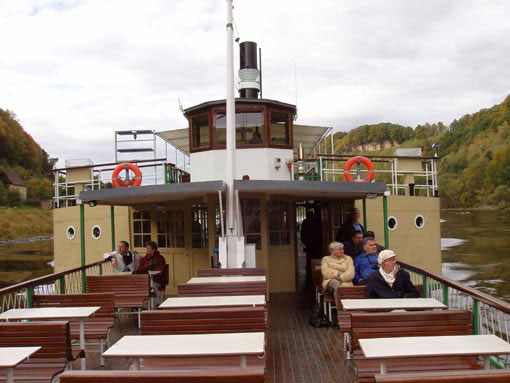
A view from the bow. Because the funnel needs to be lowered for some of the bridges, the whistle is located by the port side of the wheelhouse.
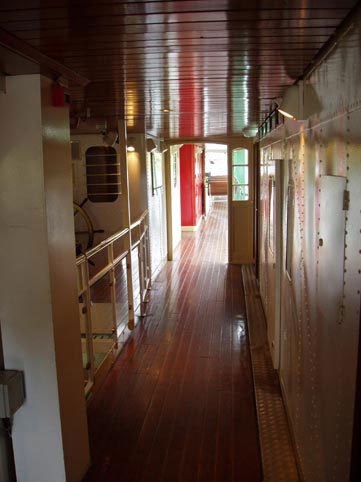
The alleyway with the engine open to view on the left and a viewing port for the paddle box on the right.
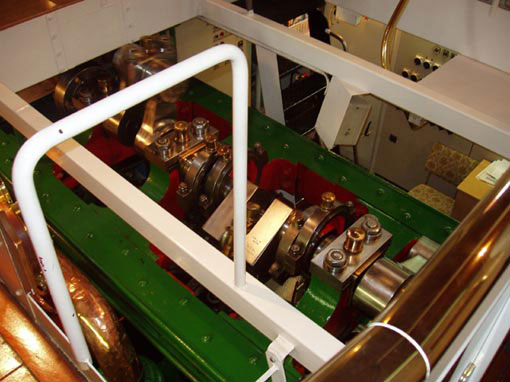
At first glance, Kurort Rathen’s oscillating engine looks as though it might have three cylinders. In fact it has only two, the centre webs being connected to the air pump. Although built in Germany, it is very similar to those supplied by the famous British engine builders John Penn and Son of Greenwich for many paddlers worldwide, as well as for some of the earlier Dresden steamers including the still operational coal-fired Diesbar of 1884 which has a stamp on the crankshaft proclaiming a ten year guarantee! These engines are very like the only remaining example of such machinery in Britain, the one taken from Cosens’ paddle steamer Empress of 1878 after she was scrapped in 1955 and now on display in the Southampton Maritime Museum.
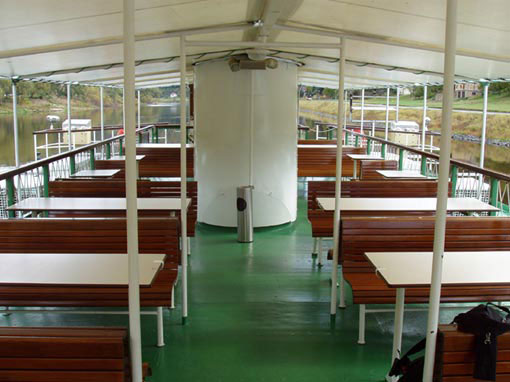
On the upper deck looking forward towards the funnel and bridge.
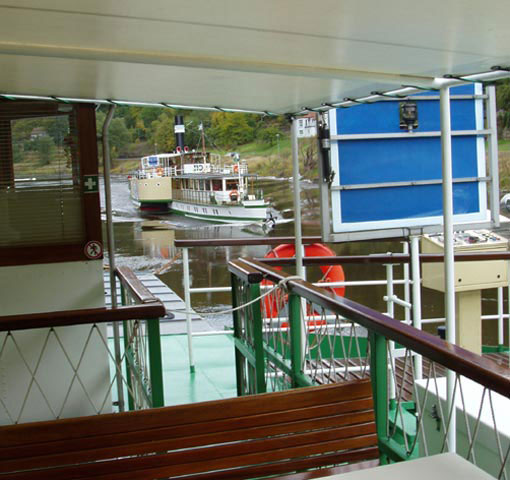
On British rivers, including the Thames, it is an absolute requirement now to navigate on the starboard side and for ships to pass port side to port side, red to red, a requirement with which it is not always easy to comply. For example, sometimes a ship may have good reason to cross the river to make an approach to go alongside a pier or a jetty on the opposite bank. And all experienced river users know that sometimes it can be highly beneficial to cross over onto the “wrong” side to take advantage of tidal back eddies etc. But all this is banned in the UK. However, on the European rivers such practice is permitted, encouraged and well regulated using the “blue flag” system which now incorporates automated blue flag boards (shown in the picture above) which can be activated by a touch of a switch by the captain. If a ship wishes to cross the river and pass another starboard side to starboard side, green to green, it puts up its blue board and, if the approaching vessel agrees, it puts up its blue board too. This works extremely well on European waterways some of which, like the Rhine, have very fast flowing currents and are highly congested with a large volume of both cargo and passenger vessels of many sizes. It is considered to be a very safe and successful system. In the picture above the paddle steamer Pillnitz of 1886 gracefully slides past the Kurort Rathen green to green with both ships displaying their activated blue “flags”.
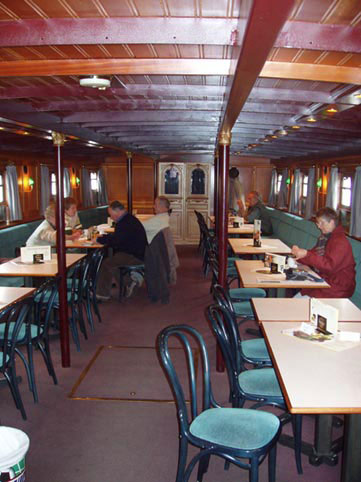
After the collapse of the East German regime and the re-unification of Germany all the operational Dresden paddle steamers received a major rebuild with work being done to a very high standard. The saloons, like the lower aft one on the Kurort Rathen pictured above, have been refurbished in a traditional manner. This is a great improvement on the 1950s style modern Formica I remember from my first trip aboard the Dresden fleet some years ago although the new decor on all the steamers is rather similar so that it can be easy to forget which ship you are on. Nonetheless the saloons have a delightful ambiance and there is always the prospect of a plate of scrumptious Saxon sausages served with potato salad topped with diced chives and spring onions and accompanied by one or perhaps two (or sometimes even three – who’s counting?) large glasses of good German beer. Saxon Switzerland is very much a traditional scenic German walking holiday area and the ships often have passengers aboard sporting huntsmen green hats topped with arrays of colourful feathers; full lederhosen; and boots that look as though they have been made for the serious business that walking can be in the hands, or rather on the feet, of the truly determined.
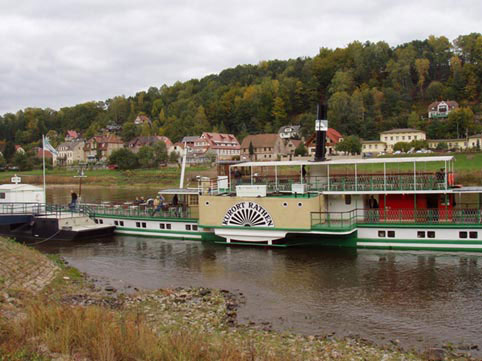
The steamers use small pontoon piers onto which they put either the bow or the stern for loading passengers according to which way they are going and the current or eddies on the piers. This means that the paddle box itself is rarely alongside a pier which has the bonus of protecting the eccentric for controlling the feathering gear of the paddle wheels which, on most paddlers, is situated just on the inside of the paddle box, on the inside of the rubbing band where it is perfectly placed for getting biffed if the paddle box does land heavily against a solid pier.
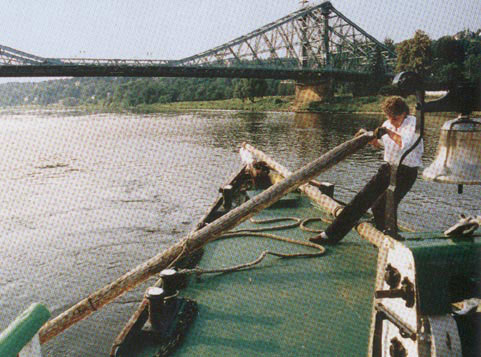
Long canting poles (rather similar to those once used on the River Dart paddlers like Kingswear Castle in the UK) used to be used on a daily basis to keep the bow or the stern off the shore when hanging off a pier and for helping to turn round short in the narrow river. These poles had a handle on one end (clearly visible in the picture above in the seaman’s hands) and a sort of spade on the other for sinking down into the river bed. Although a wonderful, traditional technique and a sight to behold, this was a cumbersome, skilled and labour intensive practice and is now not generally used since the introduction of bow thrusts to do the same job on the steamers after 1992.
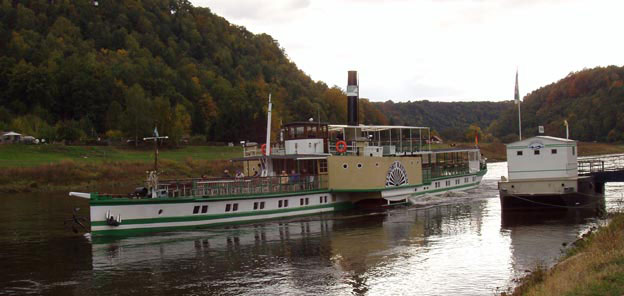
Off we go from the pontoon pier at Stadt Wehlen up river in the direction of Kurort Rathen (the village after which the ship is named), through the enchanted forests of Saxon Switzerland and past hamlets, villages and partly hidden cottages where you feel a knock on the door might give answer from Rumpulstiltskin himself. If you have not been for a trip here I highly recommend a visit. Nine paddlers; forests; rocky crags; stunning scenery; castles; Dresden itself. Come on – make a resolution – go next year!
For more information, visit the Dresden Paddle Steamers website here.
Kingswear Castle returned to service in 2023 after the first part of a major rebuild which is designed to set her up for the next 25 years running on the River Dart. The Paddle Steamer Kingswear Castle Trust is now fund raising for the second phase of the rebuild. You can read more about the rebuilds and how you can help if you can here.
John Megoran


